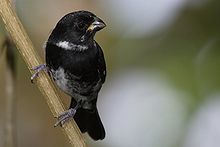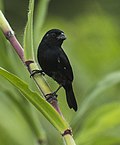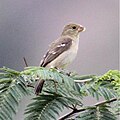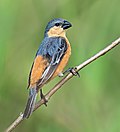Sporophila
| Sporophila | |
|---|---|

| |
| Male variable seedeater | |

| |
| Female | |
| Scientific classification | |
| Domain: | Eukaryota |
| Kingdom: | Animalia |
| Phylum: | Chordata |
| Class: | Aves |
| Order: | Passeriformes |
| Family: | Thraupidae |
| Genus: | Sporophila Cabanis, 1844 |
| Type species | |
| Pyrrhula falcirostris Temminck, 1820
| |
Sporophila is a genus of Neotropical birds in the tanager family Thraupidae. The genus now includes the six seed finches that were previously placed in the genus Oryzoborus.
They are relatively small with stubby, conical bills adapted for feeding on seeds and alike. Most species are strongly sexually dimorphic, and while "typical" adult males often are distinctive, female and immatures of both sexes can be very difficult (in some species virtually impossible) to identify to exact species.[1] Females of at least some of these species have different ultraviolet colours, which can be seen by birds, but not humans.[2] Female-like (paedomorphic) males apparently also occur, at least in some species.[3]
Taxonomy and species list[edit]
The genus Spermophila was introduced by the English naturalist William John Swainson in 1827.[4] The type species was subsequently designated as Temminck's seedeater (Sporophila falcirostris) by George Robert Gray in 1841.[5] As the genus name Spermophila had been introduced by John Richardson in 1825 for a genus of mammals,[6] the German ornithologist Jean Cabanis coined the present name Sporophila as a replacement in 1844.[7][8] The name combines the Ancient Greek sporos meaning "seed" and philos meaning "-loving".[9]
The genus now includes the six seed finches that were previously placed in Oryzoborus as well as the thick-billed seed finch that was the only species in Dolospingus. A molecular phylogenetic study published in 2014 found that these seven species were embedded in Sporophila.[10]
The genus contains 41 species:[11]
| Image | Common name | Scientific name | Distribution |
|---|---|---|---|
 |
Lesson's seedeater | Sporophila bouvronides | Bolivia, Brazil, Colombia, Ecuador, French Guiana, Guyana, Panama, Peru, Suriname, Trinidad and Tobago, and Venezuela. |
 |
Lined seedeater | Sporophila lineola | Argentina, Bolivia, Brazil, Colombia, Ecuador, French Guiana, Guyana, Panama, Paraguay, Peru, Suriname, and Venezuela. |
 |
Cinnamon-rumped seedeater | Sporophila torqueola | western Mexico |
 |
Morelet’s seedeater | Sporophila morelleti | Rio Grande Valley through eastern Mexico and Central America to western Panama |
 |
Variable seedeater | Sporophila corvina | southern Mexico through Central America to the Chocó of northwestern South America |
 |
Grey seedeater | Sporophila intermedia | Brazil, Colombia, Ecuador, Guyana, Trinidad and Tobago, and Venezuela. |
 |
Wing-barred seedeater | Sporophila americana | north-eastern Venezuela, Tobago, the Guianas, Brazil |
| White-naped seedeater | Sporophila fringilloides | Brazil, Colombia, and Venezuela. | |
 |
Black-and-white seedeater | Sporophila luctuosa | Bolivia, Brazil, Colombia, Ecuador, Peru, and Venezuela. |
 |
Double-collared seedeater | Sporophila caerulescens | Argentina, Bolivia, Brazil, Paraguay, Peru, and Uruguay |
 |
Yellow-bellied seedeater | Sporophila nigricollis | Costa Rica to Bolivia |
 |
Dubois's seedeater | Sporophila ardesiaca | east-central Brazil |
 |
Thick-billed seed finch | Sporophila funerea | southern Mexico, through Central America, to the Chocó in Colombia and Ecuador. |
 |
Chestnut-bellied seed finch | Sporophila angolensis | Trinidad, Tobago, east Colombia, Venezuela, the Guianas, Bolivia to east Brazil, Paraguay and northeast Argentina |
 |
Nicaraguan seed finch | Sporophila nuttingi | Costa Rica, Nicaragua and northwestern Panama. |
 |
Great-billed seed finch | Sporophila maximiliani | Brazil |
 |
Large-billed seed finch | Sporophila crassirostris | Brazil, Colombia, Ecuador, French Guiana, Guyana, Peru, Suriname, Trinidad and Tobago, and Venezuela. |
 |
Black-billed seed finch | Sporophila atrirostris | Ecuador, Peru and northwestern Bolivia |
 |
Slate-coloured seedeater | Sporophila schistacea | Central America, the southwestern Amazon Basin, Colombia, Venezuela, Trinidad and Tobago and the Guianas. |
 |
Temminck's seedeater | Sporophila falcirostris | Argentina and southeastern Brazil |
 |
Buffy-fronted seedeater | Sporophila frontalis | northeastern Argentina and along the southeastern Brazil |
 |
Plumbeous seedeater | Sporophila plumbea | Argentina, Bolivia, Brazil, Colombia, French Guiana, Guyana, Paraguay, Peru, Suriname, and Venezuela. |
 |
Tropeiro seedeater | Sporophila beltoni | Brazil |
 |
Rusty-collared seedeater | Sporophila collaris | Argentina, Bolivia, Brazil, Paraguay, and Uruguay. |
 |
White-throated seedeater | Sporophila albogularis | Brazil. |
 |
White-bellied seedeater | Sporophila leucoptera | Bolivia, Paraguay and eastern Brazil |
 |
Parrot-billed seedeater | Sporophila peruviana | Ecuador and western Peru. |
 |
Chestnut-throated seedeater | Sporophila telasco | southwestern Colombia to far northern Chile. |
 |
Drab seedeater | Sporophila simplex | Ecuador and Peru. |
 |
Chestnut-bellied seedeater | Sporophila castaneiventris | Bolivia, Brazil, Colombia, Ecuador, French Guiana, Guyana, Peru, Suriname, and Venezuela |
 |
Ruddy-breasted seedeater | Sporophila minuta | Brazil, Colombia, Costa Rica, Ecuador, El Salvador, French Guiana, Guatemala, Guyana, Honduras, Mexico, Nicaragua, Panama, Suriname, Trinidad and Tobago, and Venezuela. |
 |
Copper seedeater | Sporophila bouvreuil | Brazil and Suriname. |
 |
Black-and-tawny seedeater | Sporophila nigrorufa | eastern Bolivia and southwestern Brazil. |
 |
Tawny-bellied seedeater | Sporophila hypoxantha | Argentina, Bolivia, Brazil, Paraguay, and Uruguay. |
 |
Dark-throated seedeater | Sporophila ruficollis | Argentina, Bolivia, Brazil, Paraguay, and Uruguay |
 |
Pearly-bellied seedeater | Sporophila pileata | Brazil, Paraguay, northern Uruguay and northeastern Argentina. |
 |
Rufous-rumped seedeater | Sporophila hypochroma | Bolivia, Brazil, Paraguay, Argentina, and Uruguay |
 |
Chestnut seedeater | Sporophila cinnamomea | Argentina, Brazil, Paraguay, and Uruguay |
 |
Marsh seedeater | Sporophila palustris | Argentina, Brazil, Paraguay, and Uruguay. |
 |
Black-bellied seedeater | Sporophila melanogaster | Brazil. |
 |
Ibera seedeater | Sporophila iberaensis | Argentina. |
Possible extinct species:
- Hooded seedeater, Sporophila melanops – possibly extinct (20th century?), a hybrid or a color morph of S. nigricollis
References[edit]
- ^ Ridgely, R. S., & G. Tudor (1989). The Birds of South America. Vol. 1. Univ. Texas Press, Austin
- ^ Benites, P., Eaton, M. D., Lijtmaer, D. A., Lougheed, S. C. & Tubaro, P. L. (2010). Analysis from avian visual perspective reveals plumage colour differences among females of capuchino seedeaters (Sporophila). J. Avian Biology. 41: 597–602.
- ^ Areta, J. I. (2009). Paedomorphosis in Sporophila seedeaters. Bull. B.O.C. 2009 129(2): 98-103.
- ^ Swainson, William John (1827). "On several groups and forms in ornithology, not hitherto defined". Zoological Journal. 3: 158–175, 343–363 [348].
- ^ Gray (1841). A List of the Genera of Birds : with their Synonyma and an Indication of the Typical Species of Each Genus (2nd ed.). London: R. and J.E. Taylor. p. 63.
- ^ Richardson, John (1825). Appendix to Captain Parry's journal of a second voyage for the discovery of a North West passage from the Atlantic to the Pacific performed in His Majesty's ships Fury and Hecla, in the years 1821-22-23. London: J. Murray. p. 313. ISBN 9780665418341.
- ^ Cabanis, Jean (1844). "Avium conspectus quae in Republica Peruana reperiuntur et pleraeqiio observatae vel collectae sunt in itinere a Dr. J.J. de Tschudi". Archiv für Naturgeschichte (in Latin). 10: 262–317 [291].
- ^ Paynter, Raymond A. Jr, ed. (1970). Check-list of Birds of the World. Vol. 13. Cambridge, Massachusetts: Museum of Comparative Zoology. p. 133.
- ^ Jobling, James A. (2010). The Helm Dictionary of Scientific Bird Names. London: Christopher Helm. p. 363. ISBN 978-1-4081-2501-4.
- ^ Burns, K.J.; Shultz, A.J.; Title, P.O.; Mason, N.A.; Barker, F.K.; Klicka, J.; Lanyon, S.M.; Lovette, I.J. (2014). "Phylogenetics and diversification of tanagers (Passeriformes: Thraupidae), the largest radiation of Neotropical songbirds". Molecular Phylogenetics and Evolution. 75: 41–77. doi:10.1016/j.ympev.2014.02.006. PMID 24583021.
- ^ Gill, Frank; Donsker, David, eds. (2019). "New World warblers, mitrospingid tanagers". IOC World Bird List Version 9.2. International Ornithologists' Union. Retrieved 4 October 2019.
- Lijtmaer, D. A., N. M. Sharpe, P. L. Tubaro & S. C. Lougheed. 2004. Molecular phylogenetics and diversification of the genus Sporophila (Aves: Passeriformes). Mol. Philo. Evol. 33:562-579.
- Robbins, M. B., M. J. Braun, C. J. Huddleston, D. W. Finch, & C. M. Milensky (2005). First Guyana records, natural history, and systematics of the White-winged Seedeater (Dolospingus fringilloides). Ibis 147:334-341.
External links[edit]
- de Schauensee, Rodolphe Meyer (1952). "A review of the genus Sporophila". Proceedings of the Academy of Natural Sciences of Philadelphia. 104: 175–181. JSTOR 4064459.
![]() Media related to Sporophila at Wikimedia Commons
Media related to Sporophila at Wikimedia Commons
